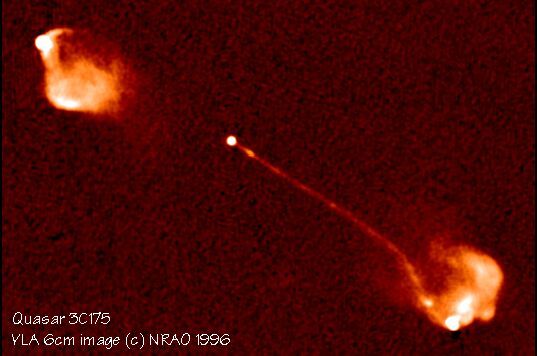Radio Quasar 3C175
Description
This image shows the radio emission from relativistic streams of high energy particles generated by the quasar. This is a classic double-lobed radio source. Astronomers believe that the jets are fueled by material accreting onto a super-massive black hole at the center of the host galaxy (not shown in this image). The high energy particles are confined to remarkably well collimated jets, and are shot into extragalactic space at speeds approaching the speed of light, where they eventually balloon into massive radio lobes. The overall linear size is of the radio structure is 212 kpc (for a Hubble constant of 100 km/s/Mpc), which can be compared to a typical galaxy diameter of about 30 kpc. The quasar has double lobes with prominent hot spots, and has a narrow jet, but no counter-jet. Its possible that we only see the jet that is pointing toward us, which may be "Doppler boosted" in brightness when the particles emitting the radio radiation are moving toward us at close to the speed of light. The counter-jet would be moving away from us, and would thus not experience Doppler boosting. The jet brightens and bends as it enters its lobe.
This quasar is at a redshift of z=0.768. VLA 4.9 GHz image at 0.35 arcsec resolution.
Creator
Legacy Astronomical Images
Rights
NRAO/AUI/NSF does not hold full copyright for this image. Contact the archivist for details.
Type
Legacy Astronomical Image
Object Name
3C175
Investigators
Alan Bridle, David Hough, Colin Lonsdale, Jack Burns, Robert Laing
Telescope
Very Large Array (VLA)
Observation Date
1986-03-29
Type of Observation
continuum
Band
C
Wavelength
6 cm
Frequency
5.0 GHz
Center of Image
RA 7:13:2.400, Dec: 11:46:14.600
Field of View
0.020000 x 0.010000 degrees
Link to journal article
Series
Active Galactic Nuclei Series
Unit
Quasars Unit
Citation
Legacy Astronomical Images, “Radio Quasar 3C175,” NRAO/AUI Archives, accessed April 3, 2025, https://www.nrao.edu/archives/items/show/33352.

